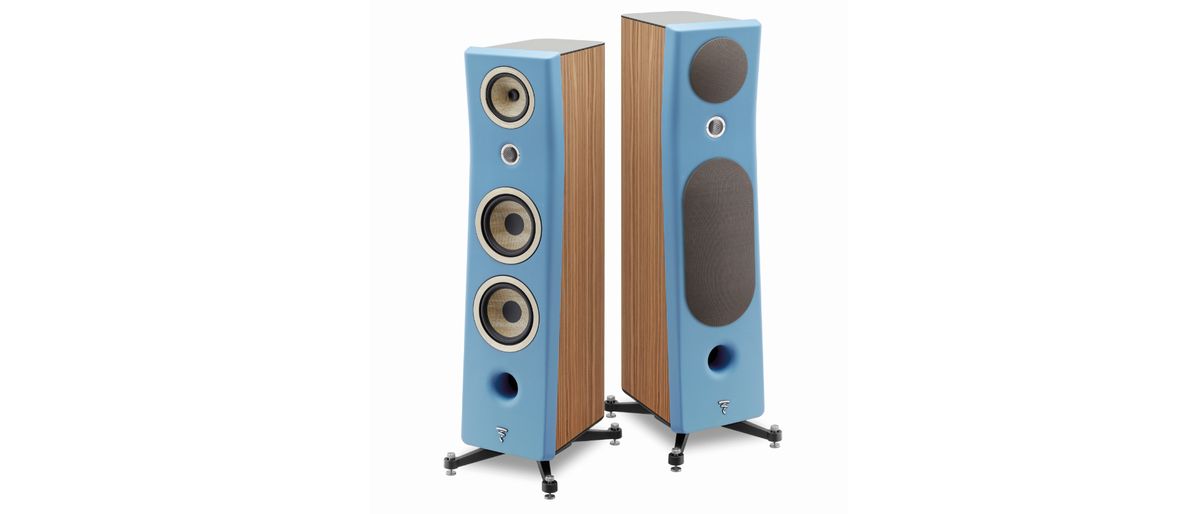
Focal Kanta No.3 review
Supreme synthesis of sound and style Tested at £9000 / $11999 / AU$20500
| Our Verdict |
|---|
| In the world of high-end loudspeakers, it's a fine art avoiding the trap of diminishing returns, but the Focal Kanta No.3 rides perfectly in the sweet spot – delivering terrific sound quality and a stylish design for its price. |
| For |
| • Trés, trés chic • Glorious mid-range • Extended bass |
| Against |
| • No bi-wiring • Fiddly grille fit on mid |
Aus Hi-Fi mag review
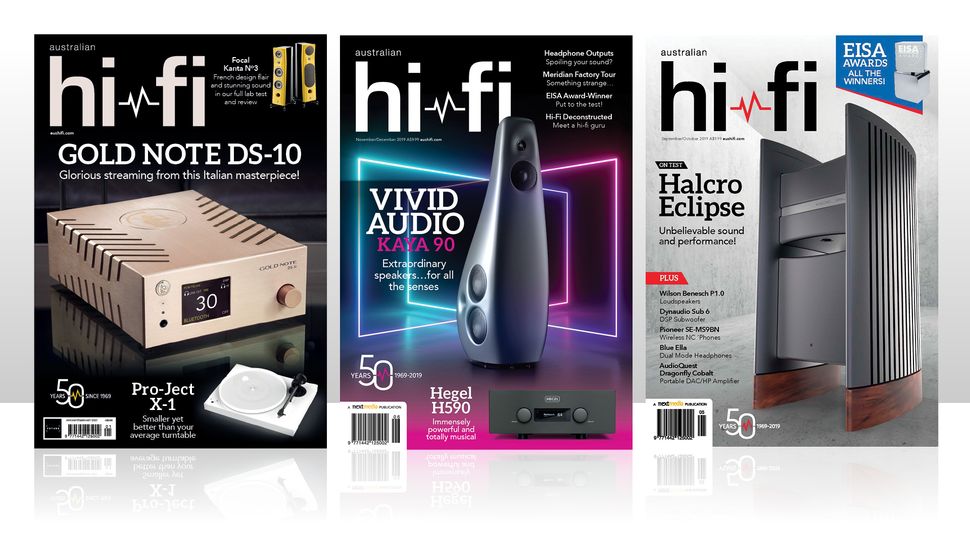
(Image credit: Future)
This review and test originally appeared in Australian Hi-Fi magazine, one of What Hi-Fi?’s sister titles from Down Under. Click here for more information about Australian Hi-Fi, including link to buy individual digital editions, and details on how to subscribe.
The Focal Kanta No.3 is the top-of-the line model in this French manufacturer’s range of home loudspeakers, weighing in at £9000 ($11,999, AU$20,500). The next step up would be to the Sopra Series, and from there it’s quite a leap to the premiere Utopia Series, whose flagship model, the Grande Utopia EM EVO, will set you back a cool £169,999 ($260,000, AU$450,000). Which makes the Kanta No.3 look like something of a bargain, really…
Equipment
TheFocal Kanta No.3s are large loudspeakers, standing 1.28 metres tall on their unique integral Zamac base. But they’re so drop-dead gorgeous that you’ll wish they were even larger, so you could gape at even more gorgeousness. The Italians might be known for their style, but the French are renowned for their chic… there’s even a French word for it – and these Kanta No.3s are very definitely chic – trés chic, in fact.
If you’re looking at the photo accompanying this review and wondering what all the fuss is about, I can assure you that it doesn’t do them justice. These are speakers you really have to see in the flesh – in flagrante delicto – to appreciate how good they look.
There’s the curve of the front baffle, which is available in patriotic* Gauloises Blue, Carrara White, Black Lacquer or Solar Yellow, all of which contrast beautifully against the main cabinet finish of high-gloss black. Or, if you’d prefer a wood veneer cabinet, you then get to choose between front baffle finishes of Warm Taupe, Dark Grey, Ivory and Gauloises Blue.
(*I’m saying ‘patriotic’ because in France, the smoking of Gauloises – the national cigarette – was for many years considered patriotic, particularly following WW1, a conflict during which almost all the poilu – French infantryman – smoked the original, filterless version.)
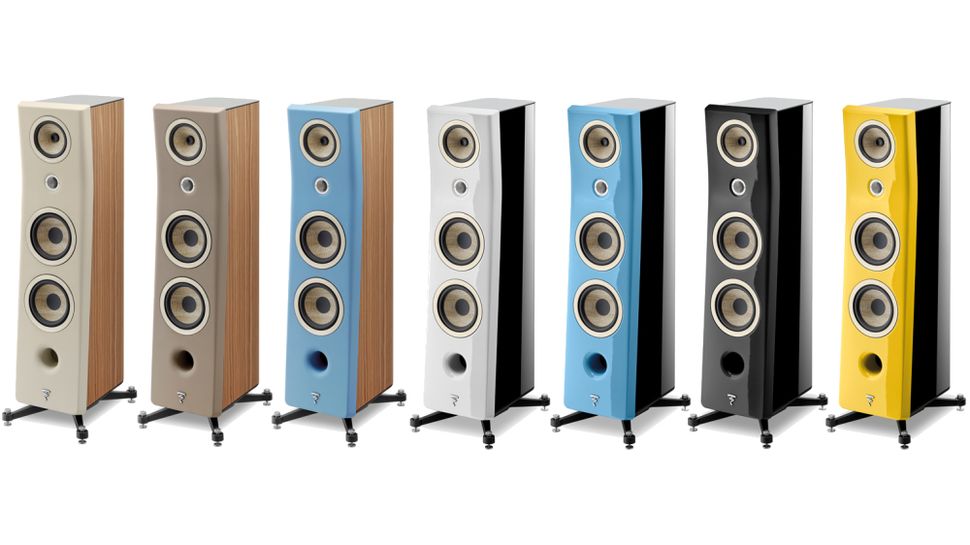
In addition to the rather sexy curve of the cabinet, there’s a slight tilt that pushes everything just slightly off the vertical, visually softening the lines. But perhaps one of the most attractive elements is the baffle itself, which is moulded in one piece from a High Density Polymer (HDP) material that is 70 per cent denser than MDF, 15 per cent stiffer than MDF and provides 25 per cent more damping than MDF.
Although my review sample was finished in ‘Black Lacquer’ it seemed to have a tiny metal-flake ‘fleck’ that gave it a wonderful visual depth, superior to plain black lacquer.
Then there’s the unusual colour of the two bass drivers and the midrange driver, which comes about because rather than using metal or plastic to form the cones, Focal has used a natural plant material – flax (linum usitatissimum).
Flax is a beautiful-looking blue-flowered plant whose stalk is most often cultivated to make linen, as used in high-quality bed sheets. It’s a very useful plant, because while its stalk is used to make textiles, its seeds can be eaten or turned into (linseed) oil. It’s hardly surprising that Focal should use flax, because French flax is considered the best in the world, particularly those varieties cultivated in Picardy, Normandy and the Pas-de-Calais region, where they have hectares of it growing.
Of course you can’t just use flax on its own for a cone material – it’s too soft. So Focal has trickled down the ‘W’ and ‘K2’ ‘sandwich’ techniques it uses to build the drivers used in its top-line models down to the Kanta No.3, so that its flax core has a fibreglass layer on either side, forming what Focal calls an ‘F’ driver.
Focal says the nature of the ‘F’ driver’s construction, along with the materials used, results in a cone that exhibits high internal damping, high velocity of sound and high rigidity – exactly what every loudspeaker designer demands in a cone. The construction of the cone varies with application. The bass drivers mostly have a 250g/m² flax core and 100g/m² glass layers, while the midrange drivers have 150g/m² flax core and 50g/m² glass layers.
However, no matter how stiff a cone is, it has to be allowed to move freely, and this is where Focal has developed a unique surround for its 165mm midrange driver, one that it has patented. If you look at the rubber at the circumference of the midrange cone (and it’s a rubber, not a foam, so it won’t deteriorate in Australia’s harsh UV-rich environment) you’ll see there are curious ‘bumps’ moulded into it.
These ‘bumps’ form what’s called a ‘Tuned Mass Damper’ (TMD) that Focal says prevents resonances from adversely affecting the pistonic behaviour of the cone. Focal says it’s the same engineering solution that’s used to build earthquake-resistant skyscrapers.
Neutral Inductance Circuit
The magnets in the three cone drivers in the Focal Kanta No.3 all feature Focal’s Neutral Inductance Circuit (NIC). This is not an electrical circuit but a magnetic one – or rather a small part of a larger magnetic circuit.
One major problem with all moving-coil drivers (also known as dynamic drivers) is that their operation is dependent on the interaction between two magnetic fields, the one surrounding the driver magnet and the other surrounding the voice coil. Without an audio signal going through the voice coil, the coil doesn’t have a magnetic field and the magnetic field of the driver magnet is therefore stable.
The problem that arises is that when you pass an electrical current (i.e. an audio signal) through the voice coil, it creates a magnetic field around the coil that then interacts with the magnetic field around the magnet and causes the voice coil to move one way or the other, but as the voice coil moves through the magnetic field it distorts it, which then means that the movement of the coil will depend on where the coil is located in relation to that field as well as the voltage through the coil.
Since the movement of the voice coil is what moves the speaker cone that creates the sound waves, the fact that everything is constantly changing makes it difficult to build a driver that has both a flat frequency response and low distortion.
Driver manufacturers use different methods in order to ameliorate this problem (often using several different methods at once) and one common method is to add a Faraday ring (sometimes called a flux modulation ring, or ‘shorting ring’) to the magnetic circuit, either at the top or bottom of the pole piece. This reduces and linearises the voice coil’s inductance, resulting in reduced distortion and a more predicable frequency response.
Faraday rings aren’t new – driver manufacturers have been using them for more than half a century, but Focal has used its very expensive Klippel analyser to optimise the dimensions of the Faraday rings it uses and their positions in the magnetic field to produce superior results over the usual ‘off-the-shelf’ Faraday rings.
As well as benefiting speaker performance, a speaker whose inductance is stable presents an easier load for the driving amplifier, so you get better performance from your amplifier, as well.
Three-way design attributes
The Focal Kanta No.3 is a three-way speaker, which is my preferred design, because it means that the bass driver – or drivers (plural) in this case, because the Focal Kanta No.3 has two of them sharing the bass duties – delivers only bass frequencies, and the midrange driver delivers only the midrange frequencies. This means that the bass notes can’t ‘muddy’ notes in the midrange, either through compression effects or, more significantly, via the phenomenon of Doppler distortion.
Loudspeaker manufacturers prefer to keep very quiet about Doppler distortion because they all sell two-way loudspeakers, and all two-way speakers suffer from it.
You’re likely already familiar with the principle of Doppler distortion. If you’re standing beside a railroad and a train goes past you with its whistle blowing, you will hear the pitch of whistle as being a higher frequency when the train is approaching than you do when it’s at its ‘proper’ (lower) frequency when the train is alongside, and finally as a lower frequency when it’s moving away. This is because the train whistle’s sound waves are ‘compressed’ when the train is approaching the listening position and ‘stretched out’ when it’s departing that position.
Now think about a loudspeaker driver that has to produce both bass and midrange sounds because the particular cabinet in which it’s fitted does not have a midrange driver. And let’s imagine that that driver is producing a deep bass note at 20 cycles per second (i.e., 20Hz), so it’s moving back and forth 20 times per second. At the same time, it’s also producing a midrange note at 1,000Hz, which means it’s also moving back and forth one thousand times per second at the same time that it’s moving back and forth 20 times per second.
This means that instead of hearing a 1,000Hz tone, we will actually hear 1,020Hz as the cone moves towards us and 1,980Hz when it’s moving away. It’s only when the cone is midway through producing the 20Hz signal that we will hear the correct frequency of exactly 1,000Hz. That’s how Doppler distortion affects loudspeakers, and it is present in all two-way loudspeakers.
In a three-way design, such as this Focal Kanta N0.3, in the previous scenario the two bass drivers will be producing the 20Hz tone, moving back and forth freely without having to deliver the 1,000Hz tone, and the midrange driver will be reproducing the 1,000Hz tone at exactly 1,000Hz, with no frequency variations at all. The advantage of a three-way loudspeaker design with its separate midrange driver is obvious!
In the case of the Kanta No.3, the bass drivers are each rated at 210mm in diameter, but the total moving diameter (cone plus roll surround) is 180mm and the Thiele/Small diameter is 168mm. This puts the cone area (Sd) at 222cm². This means that if Focal had used a single driver to deliver the bass, rather than two, that driver would have had to have had an overall diameter of around 290mm in order to move the same amount of air as the two bass drivers it has used.
The energy from the rear of these drivers is harnessed by an unusual dual bass reflex port arrangement, whereby one port (190mm long and 60mm in diameter) exits through the front baffle while the other (90mm long and 65mm deep) exits from the rear panel. Both ports are radiused at both entrance and exit. According to Nicolas Debard, of Focal: "the benefit of having two ports mainly consists in an easier positioning in the room to make the speakers less sensitive to a positioning near a front wall".
Beryllium has been Focal’s preferred dome material of choice for a good many years now, as has its use of an ‘inverted’ dome geometry for its tweeters, whereby rather than bulging outwards, as with most dome tweeters, Focal’s tweeter domes are concave.
The 27mm beryllium inverted dome IAL3 tweeter in the Focal Kanta No.3 further benefits from being fitted with Focal’s patented ‘IHL’ (Infinite Horn Loading) technology. This means that the rear of the dome is loaded via a small cavity which is connected to the exterior of the enclosure by a horn whose volume is filled with damping material, so all the energy from the rear of the dome is absorbed, rather than being reflected.
This approach is not dissimilar to the system developed by Laurence Dickie when he was designing speakers for B&W, but is obviously different enough for Focal to have gained a patent for it. As for the IAL (Infinite Acoustic Loading) that’s referenced in the model name of the IAL3 tweeter (the ‘3’ stands for third generation by the way), those letters refer to the way by which pressures from the sides of the dome are redirected.
In use
You’re going to appreciate Focal’s ‘Zamac’ base, because it makes speaker positioning and alignment (and re-positioning, if you have to) dead easy. Unlike most other speaker designs, where you have to reach in underneath a cabinet with one or more spanners in order to adjust the spikes fitted to the base, the Zamac base fitted to the Focal Kanta No.3 allows you to just reach down and make adjustments quickly, easily, and without any tools.
The base also increases the cabinet’s stability, which is important, because it’s large and heavy. The base takes its name from the materials used to make it: Zinc, Aluminium, Magnesium and Copper. Focal also uses Zamac to construct the diecast baskets used for its bass and midrange drivers.
Whether or not you use the speaker grilles (which attach magnetically, by the way) is up to you, really, because I found that the speakers sound the same with or without them. One thing to consider, however, is that the midrange driver does not have a protective dustcap at its centre like the two bass drivers. Instead it has what driver designers call an ‘exposed’ voice coil, which means that if your room is very dirty, dust particles may become lodged in the gap between the voice coil and the magnet – though this will not necessarily affect performance. However, because of this design, I’d suggest that even if you decide not to fit the grille that covers the two bass drivers, you should always fit the midrange grille.
Experienced hi-fi reviewers know when they’re listening to something really special when they find they’re listening to the music, rather than to the component they’re supposed to be evaluating, and that’s exactly what happened with my review of the Focal Kanta No.3s.
After having positioned the speakers in a spot that works well in my room, I settled back in the prime listening position with a coffee and an A4 paper pad, expecting to have not only fine-tuned the positioning of the speakers by the end of the listening session but to also have a few pages of listening notes scrawled out. News Flash: that is not what happened!
By the end of the first listening session not only had I not moved the speakers, but I also had not really written anything substantive about the speakers at all. I’d instead spent the entire time listening, rather slack-jawed – and with what I presumed would be an expression of disbelief set off by a very big smile – to a wide selection of music that ran the gamut from country to classical.
Yep, I hadn’t been listening to the speakers at all – I’d been listening to the music, held totally in the thrall of the performances – which actually tells you everything you need to know about the sound quality of the Focal Kanta No.3s.
When you listen to the Focal Kanta No.3s for yourself, I expect that initially, you’ll do the same thing as me… you’ll be held in the thrall of the music. However, I’d suggest that if you can step back from this, what you will immediately notice is that you’re hearing – and appreciating – the entire sound field as a sonic force.
The sound is simply that: sound. You’re not hearing ‘bass’ and ‘midrange’ and ‘treble’, you’re hearing all three, perfectly melded, totally cohesive and seemingly indivisible. Yet it’s not an amorphous wall of sound, it’s a tangible, textured apparition, with perceptible depth, height and width.
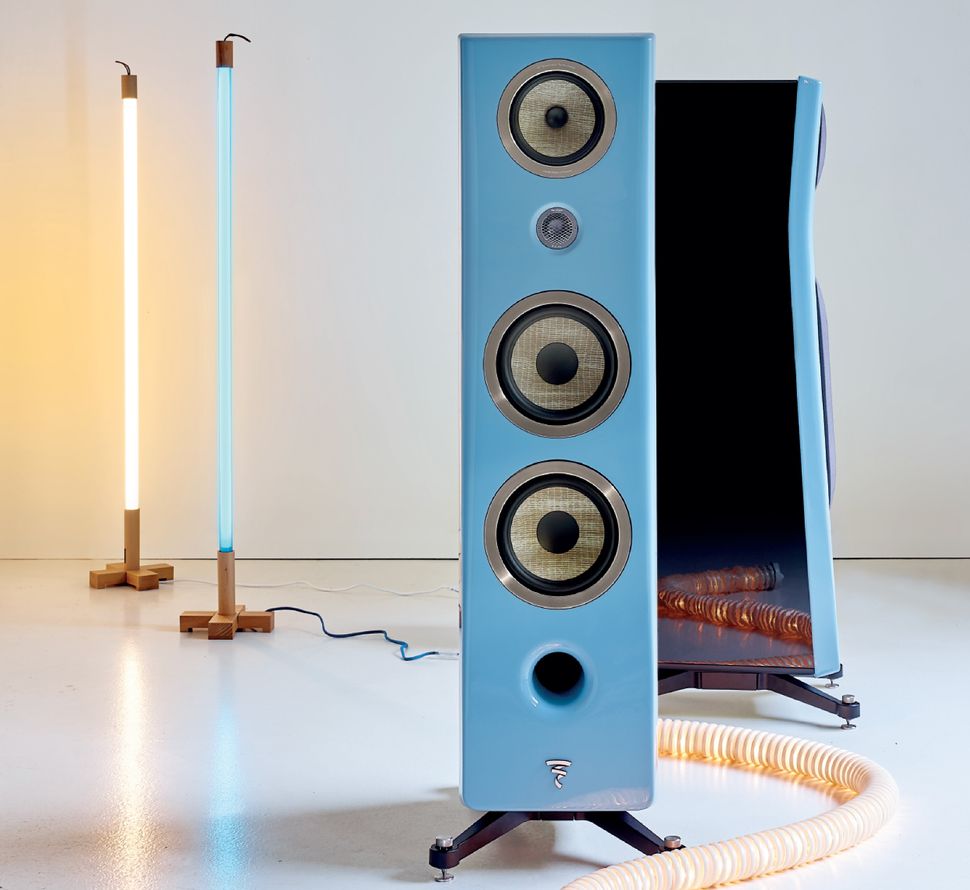
If you want to hear some really deep bass from the Kanta No.3s – as well as some ordinary low-frequency bass, but very cleanly recorded – you could do what I did and listen to what many claim is Linda Ronstadt’s finest album, Winter Light, which has on it her cover of Anna McGarrigle’s Hearts Awakening, which has bass down to 11Hz.
As you’re listening, bear in mind that this album was a failure for Ronstadt, despite the lush Enya-like sound, and that she sings perfectly songs that were penned by the likes of Brian Wilson, Carole King, Jimmy Webb, Emmylou Harris, Burt Bacharach… well, you get the idea. And to celebrate the anniversary of the moon landing as well as plumb the depths of the Kanta No.3’s bass capabilities, I also used them to play back the soundtrack of the NASA doco The Dream Is Alive which includes the thunder of the Discovery shuttle launch. Awesome! (But rather poignant viewed now, since it contains footage of Francis Scobee and Judith Resnik, who were to die in the Challenger disaster two years later).
Listening to Jim Keltner’s drumming on Sheffield Lab’s Drum & Track album I heard a perfectly-tuned bass drum with incredible dynamics, as well as superb rim shots and great brushwork. Listening to Kanine’s What I Said, I revelled in the way the Kanta No.3s were able to reveal the pitch of any low-frequency sound immediately… which is a stunning achievement considering the frequencies involved. The ‘space-y’ sound of this track further revealed the incredible dynamics of which the Kanta No.3 speakers are capable of, as well as the ability of the tweeter to handle complex synthesised high frequencies without any distortion whatsoever.
Switching to music that made things rather easier for the tweeter simply proved that Focal’s new IAL3 beryllium tweeter will deliver any sound within its pass band with aplomb. Violin sound is sweet and pure, with no harshness at all. Triangles tinkle effortlessly, the echoes simply hanging in the air. These sounds are perhaps best-heard on-axis, but the off-axis sound is equally satisfying, if somewhat lower in level at the extreme highs.
Just listen to the warmth of Hilary Hahn’s instrument as she plays Beethoven’s Violin Concerto in D Major, Op. 61 with David Zinman and the Baltimore Symphony Orchestra (Sony SK60584). Her ability to generate this level of warmth from her violin sets her apart as a genius, rather than a virtuoso. By way of comparison, listen to Leila Josefowiczs’s tone on John Adams’s Violin Concerto with Robertson and the St Louis Symphony (Nonesuch). And as for the sound of the Baltimore’s string section when playing the Beethoven, just listen to the short, clean strokes in the opening tutti.
But the star of the show is indubitably the Kanta No.3’s midrange, of which reviewer and Stereophile magazine founder J. Gordon Holt once rightly (and famously) said: "If the midrange isn’t right, nothing else matters". The Kanta No.3s get the midrange oh so right.
Just listen to them reproducing what is likely currently the most beautiful voice in the world, that of Anna Netrebko. Listening to her singing Elettra’s Aria from Idomeneo (The Mozart Album, DG 00289 477 6297) through the Kanta No.3s , the despair – and the anger – in her voice is palpable and the Focals clearly reveal the intensity she brings to her delivery as well as highlight the ways she finds to colour and inflect her lines.
Although everything Netrebko sings is glorious, her very best performance (IMHO) is the one she gave with Placido Domingo and Rolando Villazon at an open-air concert in Berlin in 2006, available on DVD (The Berlin Concert: Live from the Waldbühne). The relaxed nature of this commemorative event (all three clutch glasses of champagne!) seemed to allow her to relax totally, and her voice on this DVD is so exceptionally beautiful it brought tears to my eyes, as it will to yours… and will even if you’re not a fan of opera. Listen to the perfection of her vocal tone and delivery on Meine lippen sie küssen so heiss, as just one example.
One advantage of this concert being on DVD is that as well as hearing how relaxed and comfortable she is, you can also see how relaxed she is, such as when she almost dances during Franz Lehar’s Giuditta whilst singing "my mother was a dancer". But the tour-de-force during this concert – the absolute party-stopper – is when she sings her encore as Musetta (in Quando m’en vo’soletta, from La Bohème). It’s a moment in time you’ll never forget, and nor will those who were present… just check the reaction from Armiliato!
The stereo imaging and soundstaging presented by the Focal Kanta No.3s is worthy of special mention, as it’s so focused you can even hear the subtle, minuscule changes in tone as singers move their microphones whilst singing (or move from side to side while singing into fixed microphones).
It must be said that this significant attribute is one that’s made possible by mass production. Carefully produced mass-produced products are identical… something that can’t be said of ‘hand-made’ products, most particularly when different people are building the same thing.
Indeed the individuality made possible by hand-building may be prized when you’re making something like glassware, but when you’re building speakers, it’s an anathema: you want every single driver to be indistinguishable from any other.
Final verdict
The science of loudspeaker design is like any science: it obeys the law of diminishing returns. For anyone buying loudspeakers, this means that the more you pay, the better the sound will be, but there will eventually come a point at which the increased costs are not matched by similarly satisfying increases in sound quality.
The ideal is to find a speaker at the ‘sweet spot’ where the balance is just right for both your ears and your own budget. For me, the Focal Kanta No.3s represent that ‘sweet spot’. For you? You’ll obviously have to make that judgement for yourself – but I do sincerely recommend that you at least listen to a pair of Kanta No.3s… no matter what price you might originally have had in mind.
Test lab results
Newport Test Labs measured the frequency response of the Focal Kanta No.3 as 37Hz to 40kHz ±4dB, which is an outstanding result that shows both the bass and treble extension of which this speaker is capable. This is the response that’s shown in Graph 1.
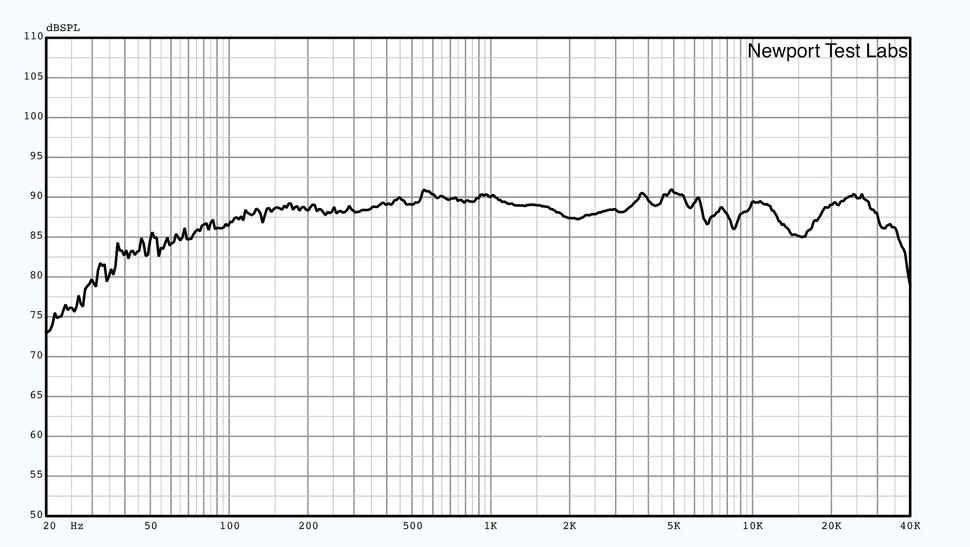
This trace is a post-processed, so that below 500Hz the trace is the averaged result of multiple sweeps using a pink noise stimulus. The section of the trace between 500Hz and 900Hz is a nearfield response of the midrange driver acquired using a swept sine wave, while the section of the trace above 900Hz was measured using a gated spot sine test signal, which simulates the result that would be obtained if the speaker were measured in an anechoic chamber.
You can see from Graph 1 that even if we tighten the dB reporting window, the response is still very linear and extended: 50Hz to 36kHz ±2.5dB, while across the all-important midrange, the measured frequency response is essentially within ±1.5dB! These are truly outstanding results.
It’s also important to note that the response is not spectrally skewed to favour any one frequency band over another—we basically see an extraordinarily flat midrange with a slow smooth roll-off in the bass and a slow smooth roll-off at high frequencies.
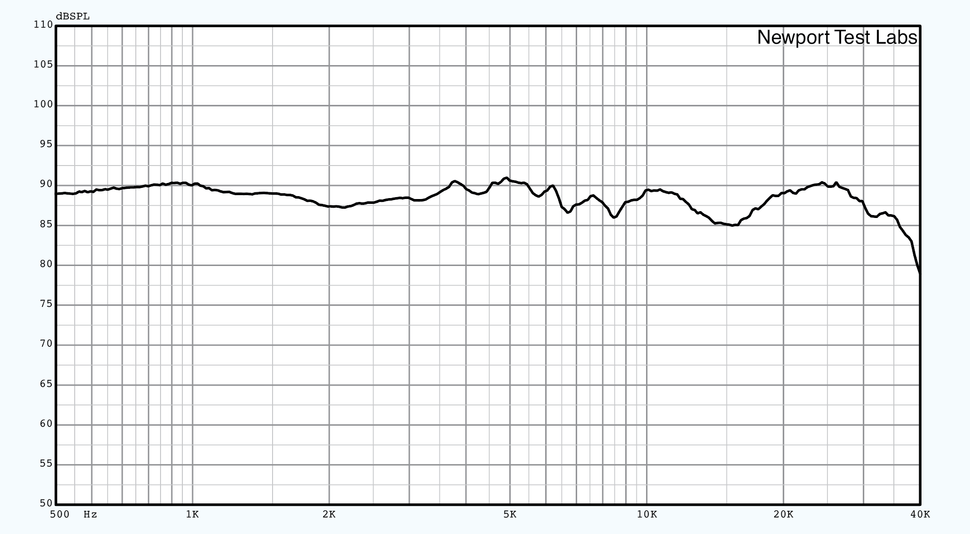
Graph 2 shows the high-frequency performance of the Focal Kanta No.3 in extreme detail from 500Hz (this low frequency limited by the graph) up to 40kHz (this upper limit dictated by the limit of calibration for the measurement microphone), yet you can still see the incredible smoothness of the Kanta No.3’s response. There are very minor variations in level, but nothing untoward, and there are absolutely no resonances.
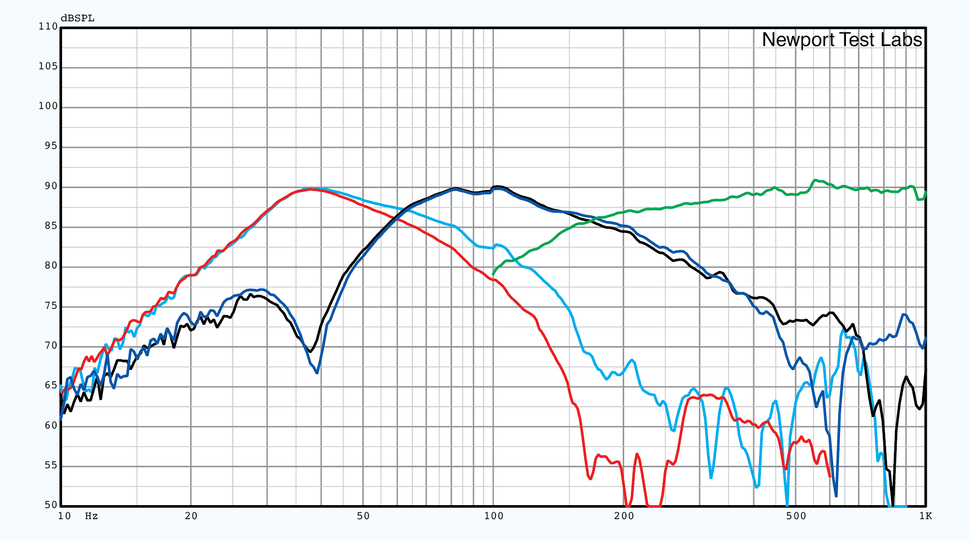
The low-frequency performance of the Focal Kanta No.3 measured by Newport Test Labs is shown in Graph 3. This graph shows the output of the front-firing bass reflex port (blue trace); the rear-firing port (red trace), the response of the lower of the two bass drivers (black trace) and of the higher one (dark blue trace) as well as the response of the midrange driver (green trace).
You can see that although the maximum output for both ports is at around 37Hz, there’s more output from the front-firing port at higher frequencies than there is from the rear-firing port. This is a very nice design touch that will allow speakers to be positioned closer to the rear wall than might otherwise be usual. It’s interesting that the lower bass driver’s output is higher than that of the identical driver above it between 450Hz and 700Hz, but I suspect this is just due to some cancellation.
You can see that although Focal puts the electrical crossover point between the bass drivers and the midrange at 250Hz, the acoustic crossover is at around 175Hz.
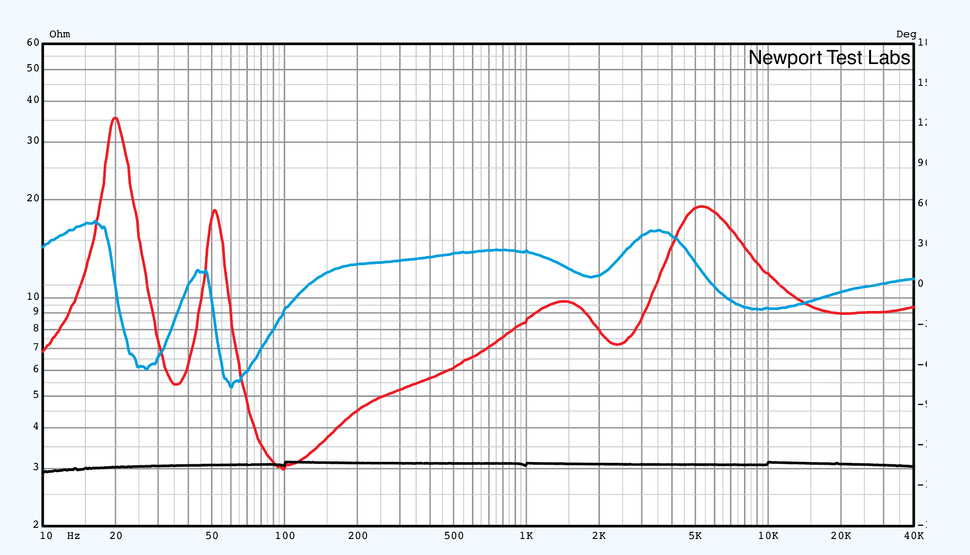
Graph 4, which shows the impedance modulus of the Focal Kanta No.3, shows that Focal is being a little ingenuous with its 8Ω nominal specification for this parameter, because if this were my design, I would have rated it as a 4Ω design, based on the fact that its impedance remains at or lower than 5Ω from 70Hz to 250Hz, with a minimum of just 3Ω at 100Hz.
However, because Focal actually states a minimum impedance (of 3Ω) in its specification, it is allowed (under the International Electrotechnical Commission rules that govern what can be legally claimed) to claim an 8Ω nominal spec. And, as you can see, the majority of the impedance trace does lie at or higher than 8Ω, so there’s a lot of technical justification for Focal’s stance. However the take-away from this impedance modulus is that you’ll get best performance if you use an amplifier that’s happy driving 2Ω loads.
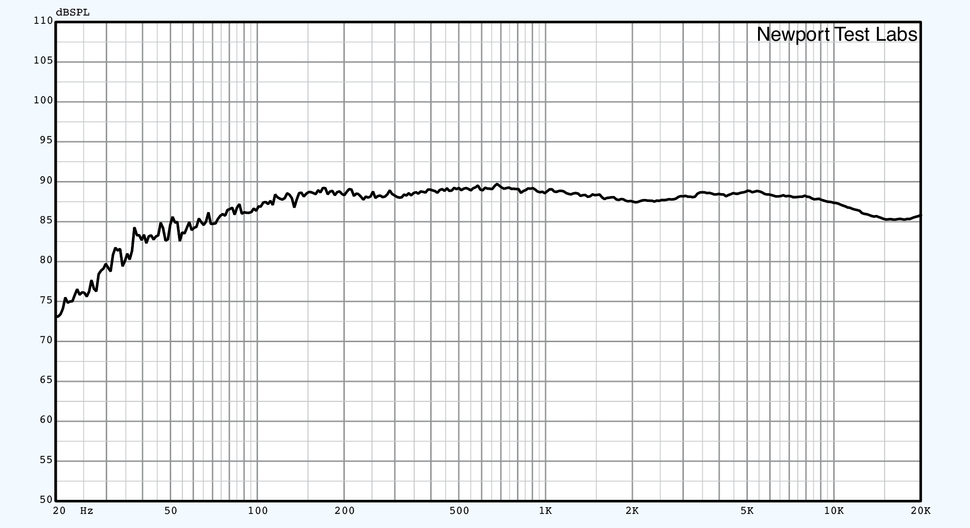
The in-room response of the Focal Kanta No.3 is shown in Graph 5, and if we allow for the inevitable vagaries of pink noise measurements made at extremely low frequencies, you can see that it returned a result of 37Hz to 20kHz ±3dB.
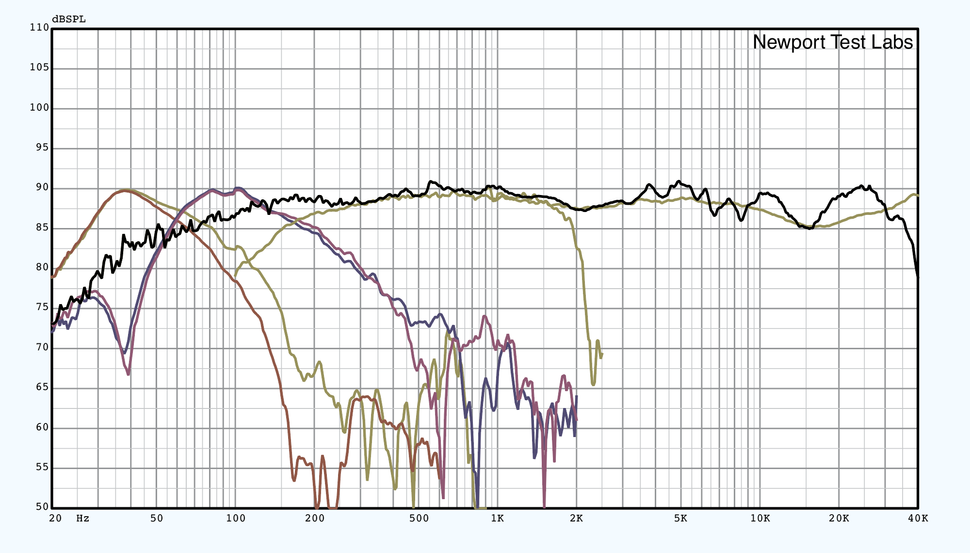
Graph 6 is a composite that puts all the response measurements from the previous graphs onto just the one, so you can see the ‘fit’ between them all. It also shows that with careful room placement, it would be possible to extract considerably more low-frequency output from the Focal Kanta No.3 than was measured by Newport Test Labs (which essentially measures low frequencies in open space, so there’s no boundary reinforcement.)
Newport Test Labs measured the Focal Kanta No.3 as delivering 90dBSPL at one metre for a 2.83Veq input, which is just 1dB shy of Focal’s specification of 91dBSPL and so easily within the bounds of measurement error. It’s a very good—and very high!—figure which means that from a practical viewpoint, you’ll be able to get the most from your amplifier, as well as generate extremely high sound pressure levels without distortion.
From a theoretical point of view, it demonstrates the superiority of the drivers Focal is using, such that its design engineers are able to extract such a flat and extended frequency response without compromising on efficiency. Overall, the laboratory tests performed by Newport Test Labs reveal that the performance of the Focal Kanta No.3 is absolutely outstanding across all measured parameters.